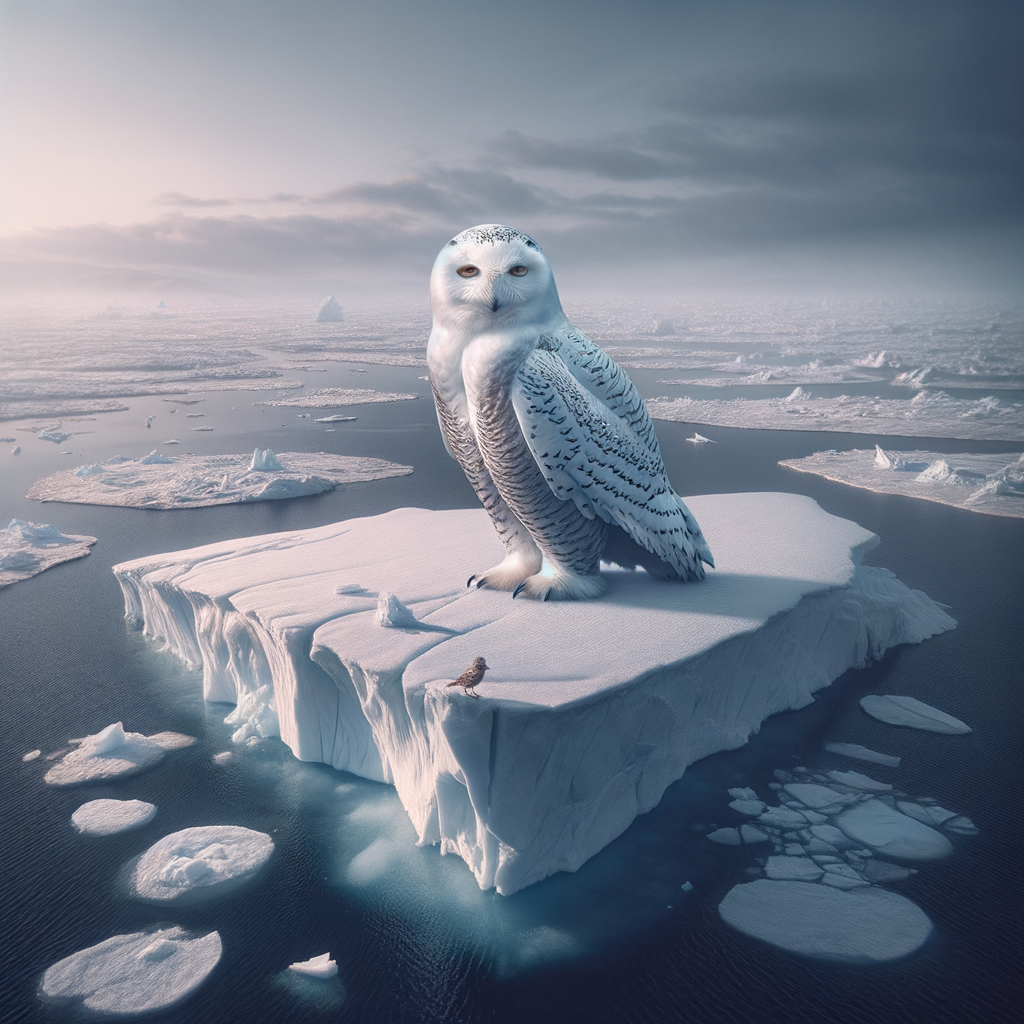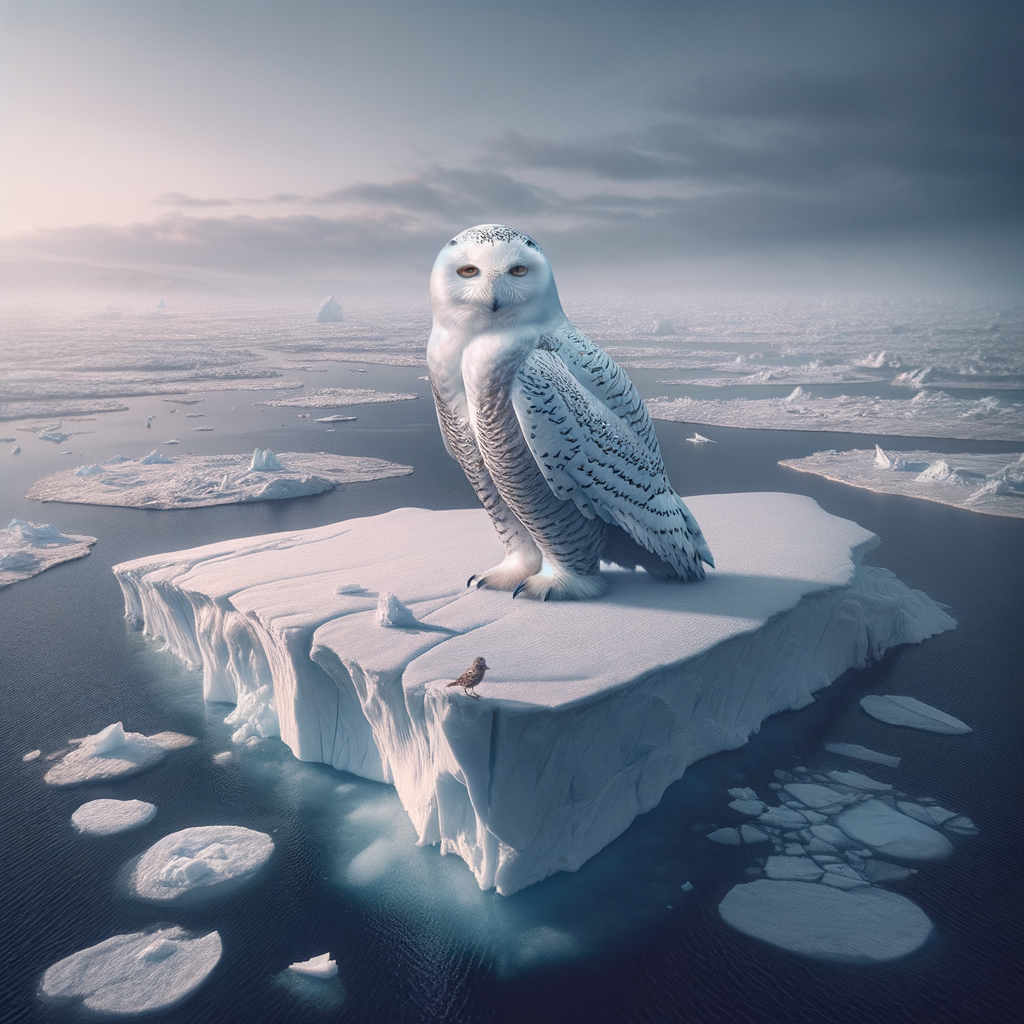
The Impact of Climate Change on Owl Populations
-
Introduction to the Topic
Climate change is a big problem for our planet. It affects many animals, including owls. Owls are birds of prey that live in different parts of the world. They are important for keeping the balance in nature. But, climate change is making life hard for them.
-
Overview of the Impact of Climate Change on Wildlife
Climate change affects all kinds of wildlife. Animals need certain conditions to live. When the climate changes, it can be too hot, too cold, too dry, or too wet for them. This makes it hard for animals to find food, water, and shelter.
For example, polar bears need ice to hunt seals. But, the ice is melting because of climate change. This makes it hard for polar bears to find food. Similarly, owls face many challenges due to changing weather patterns.
Climate Change Effects on Owls
Owl Population Decline
- Statistics and studies on owl population decline:Recent studies show that owl populations are decreasing. For example, the Barn Owl population has dropped by 50% in some areas. Researchers from the Cornell Lab of Ornithology found that many owl species are facing similar declines.
Owl Species Population Decline (%) Barn Owl 50% Snowy Owl 30% Spotted Owl 40% -
Correlation between climate change and owl population decline:
Warmer temperatures can change their habitats. For instance, Snowy Owls rely on cold climates. As temperatures rise, their hunting grounds shrink.
Additionally, changes in weather patterns can disrupt the food supply. Many owls hunt small mammals. If these animals move or die due to climate change, owls struggle to find food.
According to a study by the National Audubon Society, over 50% of North American bird species, including owls, are at risk due to climate change.
Climate Change and Wildlife
-
General impact of climate change on wildlife:
Climate change affects wildlife in many ways. Rising temperatures can change habitats. Animals may struggle to find food and water. Some species may not survive these changes. For example, polar bears need ice to hunt. As ice melts, they find it harder to catch seals.
-
Specific examples of wildlife affected by climate change:
- Coral Reefs: Warmer oceans cause coral bleaching. This harms fish that live in reefs.
- Monarch Butterflies: Changing weather patterns affect their migration. They may not find the right plants to lay eggs.
- Penguins: Melting ice reduces their breeding grounds. They also face food shortages as fish move to cooler waters.
- Sea Turtles: Rising sea levels flood nesting beaches. Warmer sand can also affect the gender of hatchlings.
Owl Habitat Loss
Global Warming Impact on Owls
- Explanation of how global warming affects owl habitats:
Global warming is causing temperatures to rise all over the world. This change affects the places where owls live. Warmer temperatures can make forests drier. This can lead to more wildfires, which destroy owl habitats. Also, warmer weather can change the types of plants that grow in an area. This can make it hard for owls to find food and shelter.
Another problem is that global warming can cause more extreme weather. Heavy rains and storms can damage trees and forests. This makes it difficult for owls to find safe places to nest. Rising sea levels also threaten coastal habitats where some owls live.
- Case studies of owl species affected by global warming:
Owl Species Region Impact Snowy Owl Arctic Warmer temperatures reduce the number of lemmings, their main food source. Spotted Owl North America Increased wildfires destroy their forest habitats. Burrowing Owl North and South America Changes in rainfall patterns flood their burrows. For example, the Snowy Owl lives in the Arctic. Global warming is melting the ice and snow in this region. This makes it harder for Snowy Owls to find their main food, lemmings. As a result, their numbers are decreasing.
In North America, the Spotted Owl is facing habitat loss due to more frequent wildfires. These fires are becoming more common because of global warming. The fires destroy the old forests that Spotted Owls need to live and hunt.
Another example is the Burrowing Owl. These owls live in burrows in the ground. Changes in rainfall patterns can flood their homes, making it hard for them to survive.
Environmental Changes and Owls
- These changes can be due to different factors like deforestation, pollution, and climate change. When forests are cut down, owls lose their homes. Pollution can poison their food and water. Climate change can make it hard for them to find food and shelter.
- Despite these challenges, some owls are adapting. For example, the Barn Owl has been found nesting in urban areas. They use buildings and barns as their new homes. Another example is the Snowy Owl. They have been seen moving to new areas where the climate is more suitable for them.
| Environmental Change | Impact on Owls | Adaptation Example |
|---|---|---|
| Deforestation | Loss of habitat | Barn Owls nesting in urban areas |
| Pollution | Contaminated food and water | None observed |
| Climate Change | Difficulty finding food and shelter | Snowy Owls moving to new areas |
These examples show that while environmental changes pose threats, some owls are finding ways to survive. However, it is important to help protect their habitats to ensure their survival.
Owl Conservation Efforts
Climate Change and Bird Species
- Impact of climate change on bird speciesWarmer temperatures and changing weather patterns can disrupt their habitats and food sources. For example, some birds may struggle to find enough food as insects and small animals they eat become less available.
According to a study by the National Audubon Society, nearly two-thirds of North American bird species are at risk of extinction due to climate change. This includes many owl species that rely on specific habitats to survive.
- Conservation efforts for bird species affected by climate changeThese efforts include preserving and restoring habitats, monitoring bird populations, and advocating for policies to reduce carbon emissions.
For instance, the National Audubon Society has launched the Climate Initiative, which aims to safeguard birds and their habitats. They work with communities to create bird-friendly environments and promote sustainable practices.
Another example is the World Wildlife Fund (WWF), which supports various projects to help birds adapt to changing climates. These projects include creating wildlife corridors and protecting critical breeding grounds.
Owls and Changing Climate
- Adaptation strategies of owls to changing climate:Owls are known for their adaptability. As the climate changes, some owl species are shifting their habitats. For example, the snowy owl is moving further north as temperatures rise. This helps them find cooler areas that suit their needs.
Another strategy is changing their hunting times. Some owls are becoming more nocturnal to avoid the heat of the day. This helps them conserve energy and stay cool.
Owls also adapt by changing their diet. They may hunt different prey that is more available in their new habitats. This flexibility helps them survive in changing conditions.
- Efforts to conserve owl species in the face of climate change:Conservationists are working hard to protect owls. One way is by preserving their habitats. This means protecting forests and other areas where owls live.
Another effort is creating wildlife corridors. These are safe pathways that allow owls to move to new habitats. This is important as their current homes may become unsuitable due to climate change.
Scientists are also studying owls to understand how they are affected by climate change. This research helps create better conservation plans. For example, tracking devices are used to monitor owl movements and behaviors.
Public awareness campaigns are also crucial. Educating people about the importance of owls and the threats they face can lead to more support for conservation efforts.
Ecosystem Changes and Owls
Impact on Owl Food Sources
-
Changes in prey populations due to climate change
For example, warmer temperatures can cause some small mammals, like mice and voles, to move to cooler areas. This means fewer prey animals are available in the owls’ usual hunting grounds.
Additionally, insects and other small creatures that owls eat may also change their behavior or population size due to climate changes. This can make it harder for owls to find enough food.
-
Effect of these changes on owl populations
When there is less food available, owls may struggle to survive. They might have to travel further to find food, which uses more energy. This can be especially hard for young owls who are learning to hunt.
In some cases, a lack of food can lead to a decrease in owl populations. If owls cannot find enough to eat, they may not be able to reproduce successfully. This can lead to fewer owls over time.
| Factor | Impact on Prey | Impact on Owls |
|---|---|---|
| Warmer Temperatures | Prey moves to cooler areas | Owls have to travel further to hunt |
| Changes in Insect Behavior | Less food for small mammals | Fewer small mammals for owls to eat |
| Decreased Prey Populations | Less food available | Difficulty in reproduction and survival |
According to Wikipedia, climate change is causing significant shifts in ecosystems worldwide. These changes can have a ripple effect, impacting many species, including owls.
Changes in Owl Breeding Patterns
- Impact of climate change on owl breeding seasonsThese changes affect the timing of seasons. Owls depend on specific seasons for breeding. Warmer winters and earlier springs can confuse owls. They may start breeding too early or too late. This can lead to fewer chicks surviving.
For example, a study found that some owl species are laying eggs earlier than before. This change can disrupt the food supply for the chicks. If the prey is not available, the chicks may not survive.
- Effect of these changes on owl populationsIf fewer chicks survive, the population can decrease. This can have a big impact over time. For instance, the Barn Owl is one species affected by these changes. Studies show that their numbers are dropping in some areas. This is partly due to changes in breeding patterns caused by climate change.
Here is a table showing the impact:
Owl Species Breeding Season Change Population Impact Barn Owl Earlier egg-laying Population decrease Snowy Owl Delayed breeding Lower chick survival
Conclusion
- Summary of the Impact of Climate Change on Owl Populations:Owls are losing their homes due to rising temperatures and changing weather patterns. This makes it hard for them to find food and shelter. Some species are at risk of disappearing if these changes continue.
- Discussion on the Importance of Conservation Efforts:Conservation efforts are crucial to help owls survive. Protecting their habitats and reducing pollution can make a big difference. People can help by supporting conservation programs and being mindful of their environmental impact. Together, we can ensure that owls continue to thrive in our world.






